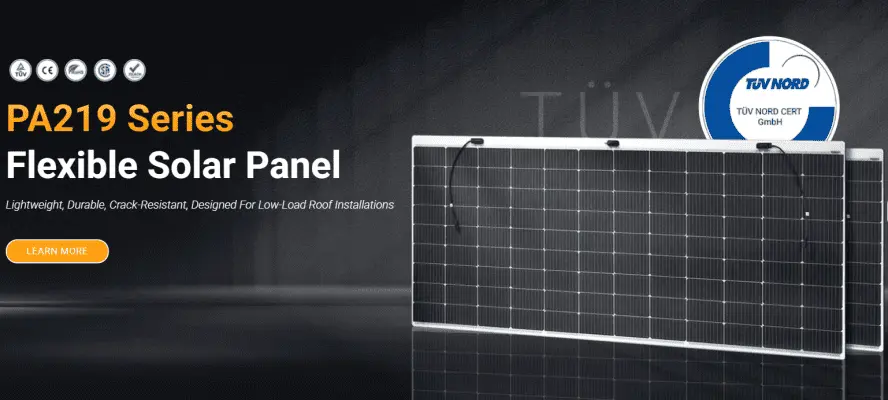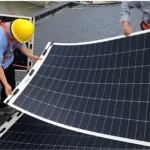In the era of climate change and rising energy prices, renewable energy sources like solar power have become essential. A 400 watt solar panel is an attractive choice for individuals and businesses aiming to contribute to environmental sustainability while reducing energy expenses. With its compact solar panel size and high efficiency, a 400W solar module offers excellent versatility and value.
How Do 400 Watt Solar Panels Work?
A 400-watt solar panel is a photovoltaic (PV) module that converts sunlight into usable electrical energy. Here’s how it works:
Photovoltaic Cell Technology:
The core of each solar cell is a silicon-based semiconductor. When sunlight hits the panel, the silicon absorbs light energy, releasing electrons that generate direct current (DC) electricity.Module Structure:
Multiple cells are connected within a stable frame, covered with protective glass, to form a solar panel. An inverter then converts DC into alternating current (AC), ready for use in homes or for feeding into the grid.Energy Output:
Under optimal conditions, a 400-watt solar panel can generate several kilowatt-hours of electricity per day, depending on sunlight exposure and location.
What Are the Key Features of a 400 Watt Solar Panel?
Compact Dimensions and Versatility:
A typical 400W solar panel size measures between 1,720–1,762 mm in length and 1,134 mm in width, with a surface area of about 2 square meters. These average solar panel sizes make them suitable for various applications, from rooftop installations to portable solar kits for sheds or RVs.High Efficiency:
Modern 400-watt solar panels achieve efficiencies up to 22%, converting more sunlight into electricity compared to smaller modules. This allows for optimal energy output, even in limited spaces.Cost-Effectiveness:
The solar panel cost per watt for a 400W module is typically lower than that of smaller panels, offering better value for money. Combining multiple panels increases energy generation at a reduced per-watt cost.Portability:
Compact and lightweight solar panel portable designs make 400W panels ideal for camping, RVs, and off-grid scenarios.

Where Can 400 Watt Solar Panels Be Used?
Home Use:
A single 400W solar panel can generate 300–450 kWh of electricity annually, enough to power household essentials like refrigerators, washing machines, or LED lighting. Combining panels can further support home heating systems or even electric vehicle charging.Outdoor Adventures:
Outdoor enthusiasts value portable solar panels for their ability to power communication devices, cooking appliances, and small electronics during camping trips or remote work.Off-Grid Systems:
When paired with storage batteries, 400W panels can support off-grid energy independence for cabins, sheds, or tiny homes.
What Are the Standard Dimensions and Types of Solar Panels?
Standard PV Panel Dimensions:
- 400W Solar Panel Dimensions: 1,720–1,762 mm (length) × 1,134 mm (width).
- Average Solar Panel Size: Approximately 2 square meters.
Types of Solar Panels:
- Monocrystalline: High efficiency, ideal for limited spaces.
- Polycrystalline: Lower production costs, slightly less efficient.
- Thin-Film: Flexible, lightweight, and suitable for unique applications but less efficient.
What Factors Influence Solar Panel Performance?
Location and Orientation:
Panels perform best when installed at a tilt angle of 30–40° and facing south. Shading from trees or buildings can significantly reduce energy output.Weather Conditions:
Clear skies maximize sunlight absorption, while clouds, rain, or snow can decrease performance.Efficiency and Size:
High-efficiency panels with optimized photovoltaic panel sizes deliver better results, especially in compact systems.
How Big is a 400 Watt Solar Panel and What Can It Power?
- Physical Size: Slightly smaller than 2 square meters, making it compact yet powerful.
- Energy Output:
A 400W solar panel can power:- A refrigerator or washing machine for a year.
- LED lighting for a household.
- Small appliances like kettles or laptops.
What Should You Consider When Buying 400 Watt Solar Panels?
- Nominal Power: Choose panels with consistent performance under various conditions.
- Efficiency: Look for panels with at least 20% efficiency.
- Warranty: Opt for manufacturers offering 25-year performance guarantees.
- Space and Shading: Ensure ample installation space with minimal shading for optimal sunlight absorption.
Why Should You Choose 400 Watt Solar Panels?
Smart Energy Solutions:
When combined with storage systems, such as Zendure SolarFlow, 400W panels allow households to store excess energy for use at night or during cloudy periods, increasing energy independence.Sustainability:
By relying on solar power, each household contributes to reducing greenhouse gas emissions and promoting a cleaner, more sustainable future.Cost Savings:
Over time, 400W panels significantly lower energy costs by reducing dependence on grid power.
Final Thoughts: Are 400 Watt Solar Panels Right for You?
A 400-watt solar panel is an excellent investment for clean, efficient, and cost-effective energy. Its versatile applications, compact solar panel dimensions, and high performance make it a popular choice for homes, outdoor enthusiasts, and businesses alike. By choosing the right pv panel dimensions, type, and system design, you can enjoy the benefits of solar power while contributing to a sustainable future.
Whether you’re building a solar kit for a shed, powering a home, or exploring the great outdoors, the potential of a 400W solar panel is vast, paving the way for energy independence and environmental responsibility.







